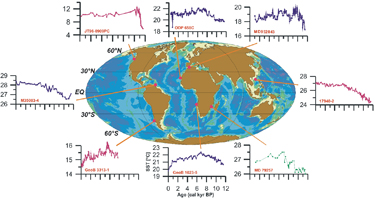|
Evaluation of Eemian and Holocene Climate Variability: Synthesis of marine archives with climate modelling
Principal Investigators: Gerrit Lohmann (AWI Bremerhaven), Ralph Schneider (University of Kiel), Johann Jungclaus (MPI Hamburg)
Project Scientists: Nils Fischer (MPI Hamburg), Guillaume Leduc (University of Kiel), Madlene Pfeiffer (AWI Bremerhaven)
Text
The major objective of the project is to investigate the spatio-temporal
pattern of temperature changes during the Eemian and Holocene as derived
from integrations with a comprehensive global climate model, marine
surface ocean temperature and oxygen isotope records as well as from
terrestrial archives on a global scale.
We will explore the worldwide distribution of existing, reedited, and
newly collected marine and terrestrial palaeotemperature data and
compare it with results from transient experiments with a
state-of-the-art general circulation model used in the assessment of
future climate change. The palaeodata collection and the modelling
efforts will aim to investigate the regionally very different temporal
climate patterns during the middle to late Holocene (the last 6,000
years) and the Eemian (125,000 years before present). Special emphasis
is placed on the last 3000 years, striving to complement a former
low-resolution study of the Holocene. With advanced statistical analysis
of spatial and temporal variability in the palaeodata records and in the
model results, natural climate variability modes and their amplitude
will be identified in the data and compared with the climate variability
tracked down in the model experiments. Pattern analysis will unravel
heterogeneity in temperature trends. The extension of the Latest
Holocene climate simulations into the next centuries, using scenarios
for future greenhouse gas emission, can help to assess future climatic
change influenced by natural and anthropogenic “forcing”. The
statistical analyses will extract climate phenomena from different proxy
time-series and elaborate common variability and teleconnections for the
last two interglacial periods. The aim is to unravel the influence of
natural forcing factors, like e.g. parameters of the Earth's orbit, on
climate variability and regional heterogeneity in climate trends. The
variations in the large-scale ocean circulation and feedback mechanisms
between thermohaline circulation changes and low-frequency variations of
climate will be investigated.
Text
Archives
Text
|
| < zurück | weiter > |
|---|


